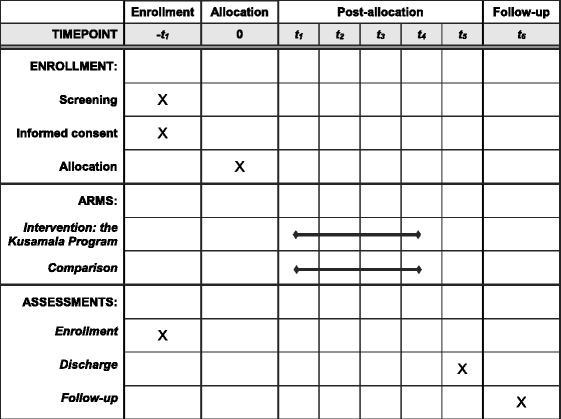The Kusamala Program for primary caregivers of children 6-59 months of age hospitalized with severe acute malnutrition in Malawi: study protocol for a cluster-randomized controlled trial
- PMID: 29149905
- PMCID: PMC5693531
- DOI: 10.1186/s13063-017-2299-3
The Kusamala Program for primary caregivers of children 6-59 months of age hospitalized with severe acute malnutrition in Malawi: study protocol for a cluster-randomized controlled trial
Abstract
Background: Severe acute malnutrition (SAM) is associated with high mortality rates and impairments in growth and development in children that do survive. There are complex nutritional, health, and behavioural risk factors involving severely malnourished children and their primary caregivers, requiring integrated intervention approaches.
Methods: A cluster-randomized controlled trial at the Queen Elizabeth Central Hospital in Blantyre, Malawi will be conducted to evaluate the effectiveness of a 4-day hospital-based intervention programme directed at primary caregivers. This programme, titled the Kusamala Program, aims to improve developmental and nutritional outcomes in children with SAM. Up to six primary caregivers and their children will be enrolled to groups each week, which will be randomly allocated to intervention or comparison arms. The intervention package consists of interactive counselling on three modules: 1) nutrition and feeding; 2) water, sanitation, and hygiene (WASH); and 3) psychosocial stimulation. Data collection will be performed at enrolment, at discharge from hospital, and at 6 months following discharge. The primary outcome is child development assessed with the Malawi Developmental Assessment Tool (MDAT), a validated measure of gross and fine motor, language, and social development.
Discussion: This intervention programme is unique because it utilizes primary caregivers' time spent in-hospital while children receive treatment for SAM. The programme has the potential to be effective in addressing multiple aspects of child, nutrition and development.
Trial registration: ClinicalTrials.gov, NCT03072433 . Registered on 7 March 2017.
Keywords: Child development; Nutrition; Psychosocial stimulation; RCT; Severe acute malnutrition; WASH.
Conflict of interest statement
Ethics approval and consent to participate
Ethics approval for this study was obtained from the College of Medicine Research and Ethics Committee (P.04/16/1930) in Blantyre, Malawi, and the Research Ethics Board (1000053578) at the Hospital for Sick Children in Toronto, Canada. Consent will be requested of all participants in the study; primary caregivers will be asked to provide consent on behalf of themselves and their children.
Consent for publication
Not applicable.
Competing interests
The authors declare that they have no competing interests.
Publisher’s Note
Springer Nature remains neutral with regard to jurisdictional claims in published maps and institutional affiliations.
Figures
Similar articles
-
A Mixed-Methods Cluster-Randomized Controlled Trial of a Hospital-Based Psychosocial Stimulation and Counseling Program for Caregivers and Children with Severe Acute Malnutrition.Curr Dev Nutr. 2021 Jul 21;5(8):nzab100. doi: 10.1093/cdn/nzab100. eCollection 2021 Aug. Curr Dev Nutr. 2021. PMID: 34447897 Free PMC article.
-
A mixed methods feasibility study of the Kusamala Program at a nutritional rehabilitation unit in Malawi.Pilot Feasibility Stud. 2018 Sep 24;4:151. doi: 10.1186/s40814-018-0347-8. eCollection 2018. Pilot Feasibility Stud. 2018. PMID: 30258650 Free PMC article.
-
The effects of psychosocial stimulation on the development, growth, and treatment outcome of children with severe acute malnutrition age 6-59 months in southern Ethiopia: a parallel group cluster randomized control trial (EPSoSAMC study).BMC Public Health. 2019 Dec 2;19(1):1610. doi: 10.1186/s12889-019-7916-5. BMC Public Health. 2019. PMID: 31791303 Free PMC article.
-
Follow-up between 6 and 24 months after discharge from treatment for severe acute malnutrition in children aged 6-59 months: A systematic review.PLoS One. 2018 Aug 30;13(8):e0202053. doi: 10.1371/journal.pone.0202053. eCollection 2018. PLoS One. 2018. PMID: 30161151 Free PMC article.
-
Determinants of Child Malnutrition and Infant and Young Child Feeding Approaches in Cambodia.World Rev Nutr Diet. 2016;115:61-7. doi: 10.1159/000444609. Epub 2016 May 19. World Rev Nutr Diet. 2016. PMID: 27197522 Review.
Cited by
-
Interventions promoting uptake of water, sanitation and hygiene (WASH) technologies in low- and middle-income countries: An evidence and gap map of effectiveness studies.Campbell Syst Rev. 2021 Oct 8;17(4):e1194. doi: 10.1002/cl2.1194. eCollection 2021 Dec. Campbell Syst Rev. 2021. PMID: 36951806 Free PMC article.
-
Pathways between caregiver body mass index, the home environment, child nutritional status, and development in children with severe acute malnutrition in Malawi.PLoS One. 2021 Aug 23;16(8):e0255967. doi: 10.1371/journal.pone.0255967. eCollection 2021. PLoS One. 2021. PMID: 34424919 Free PMC article. Clinical Trial.
-
Exploring Early Childhood Development Interventions for Building Human Capital in Sub-Saharan Africa: A Scoping Review.Child Care Health Dev. 2025 Jul;51(4):e70138. doi: 10.1111/cch.70138. Child Care Health Dev. 2025. PMID: 40667583 Free PMC article.
-
A Mixed-Methods Cluster-Randomized Controlled Trial of a Hospital-Based Psychosocial Stimulation and Counseling Program for Caregivers and Children with Severe Acute Malnutrition.Curr Dev Nutr. 2021 Jul 21;5(8):nzab100. doi: 10.1093/cdn/nzab100. eCollection 2021 Aug. Curr Dev Nutr. 2021. PMID: 34447897 Free PMC article.
-
A mixed methods feasibility study of the Kusamala Program at a nutritional rehabilitation unit in Malawi.Pilot Feasibility Stud. 2018 Sep 24;4:151. doi: 10.1186/s40814-018-0347-8. eCollection 2018. Pilot Feasibility Stud. 2018. PMID: 30258650 Free PMC article.
References
-
- World Health Organization. WHO child growth standards and the identification of severe acute malnutrition in infants and children. Geneva: World Health Organization. 2009. Available: http://www.who.int/nutrition/publications/severemalnutrition/97892415981.... Accessed 31 July 2017. - PubMed
Publication types
MeSH terms
Associated data
Grants and funding
LinkOut - more resources
Full Text Sources
Other Literature Sources
Medical



